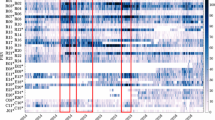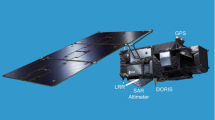Abstract
We use a series of simulated scenarios to characterize the observability of geocenter location with GPS tracking data. We examine in particular the improvement realized when a GPS receiver in low Earth orbit (LEO) augments the ground network. Various orbital configurations for the LEO are considered and the observability of geocenter location based on GPS tracking is compared to that based on satellite laser ranging (SLR). The distance between a satellite and a ground tracking-site is the primary measurement, and Earth rotation plays important role in determining the geocenter location. Compared to SLR, which directly and unambiguously measures this distance, terrestrial GPS observations provide a weaker (relative) measurement for geocenter location determination. The estimation of GPS transmitter and receiver clock errors, which is equivalent to double differencing four simultaneous range measurements, removes much of this absolute distance information. We show that when ground GPS tracking data are augmented with precise measurements from a GPS receiver onboard a LEO satellite, the sensitivity of the data to geocenter location increases by more than a factor of two for Z-component. The geometric diversity underlying the varying baselines between the LEO and ground stations promotes improved global observability, and renders the GPS technique comparable to SLR in terms of information content for geocenter location determination. We assess a variety of LEO orbital configurations, including the proposed orbit for the geodetic reference antenna in space mission concept. The results suggest that a retrograde LEO with altitude near 3,000 km is favorable for geocenter determination.













Similar content being viewed by others
References
Altamimi Z, Collilieux X, Legrand J, Garayt B, Boucher C (2007) ITRF2005: a new release of the international terrestrial reference frame based on time series of station positions and Earth orientation paramters. J Geophys Res 112(B09): doi:10.1029/2007JB004949
Altamimi Z, Collilieux X, Metivier L (2011) ITRF2008: an improved solution of the international terrestrial reference frame. J Geod 85(8):457–473. doi:10.1007/s00190-011-0444-4
Bar-Sever YE, Kuang D (2004) New empirically derived solar radiation pressure model for global positioning system satellites. The interplanetary network progress report, vol. 42–159, Jet Propulsion Laboratory, Pasadena, California, pp 1–11. http://ipnpr.jpl.nasa.gov/progress_report/42-159/159I.pdf. November 15, 2004
Bar-Sever YE, Kuang D (2005) New empirically derived solar radiation pressure model for global positioning system satellites during eclipse seasons. The interplanetary network progress report, vol. 42–160, Jet Propulsion Laboratory, Pasadena, California, pp 1–4. http://ipnpr.jpl.nasa.gov/progress_report/42-160/160I.pdf. February 15, 2005
Bar-Sever Y, Haines H, Kuang D, Nerem S (2012) Geodetic reference antenna in space (GRASP): status and simulations. AGU Fall Meeting, San Francisco, Dec. 3–7, 2012
Beutler G, Brockmann E, Gurtner W, Hugentobler U, Mervart L, Rothacher M (1994) Extended orbit modeling techniques at the CODE processing center of the international GPS service for geodynamics (IGS): theory and initial results. Manuscr Geod 19:367–386
Blewitt G, Lavallee D, Clarke P, Nurutdinov K (2001) A new global mode of Earth deformation: seasonal cycle detected. Science 294(5550):2342–2345
Cheng MK (1999) Geocenter variations from analysis of TOPEX/POSEIDON SLR data. In: IERS analysis campaign to investigate motions of the Geocenter, IERS Tech. Note 25, pp 39–44, Obs. De Paris, Paris
Desai SD, Bertiger W, Gross J, Haines B, Harvey N, Selle C, Sibthorpe A, Weiss JP (2011) Results from the reanalysis of global GPS data in the IGS08 reference frame. American Geophysical Union Fall Meeting, San Francisco, December
Dong D, Yunck T, Heflin M (2003) Origin of the international terrestrial reference frame. J Geophys Res 108(B4):2200–2209
Dow JM, Neilan RE, Rizos C (2009) The international GNSS service in a changing landscape of global navigation satellite systems. J Geod 83(3–4):191–198. doi:10.1007/s00190-008-0300-3
Gobinddass ML, Willis P, de Viron O, Sibthorpe AJ, Zelensky NP, Ries JC, Ferland R, Bar-Sever YE, Diament M (2009) Systematic biases in DORIS-derived geocenter time series related to solar radiation pressure mis-modeling. J Geod 83(9):849–858. doi:10.1007/s00190-009-0303-8
Haines BJ, Bar-Sever YE, Bertiger WI, Desai SD, Harvey N, Weiss JP (2011) A GPS-based terrestirial reference frame from a combination of terrestrial and orbiter data. AGU Fall Meeting, San Francisco (December 2011)
Haines BJ, Bar-Sever YE, Bertiger WI, Desai SD, Harvey N, Sibois AE, Weiss JP (2015) Realizing a terrestrial reference system using global positioning system. J Geophys Res, under revision
Heflin M, Bertiger W, Blewitt G, Freedman A, Hurst K, Lichten S, Lindqwister U, Vigue Y, Webb F, Yunck T, Zumberge J (1992) Global geodesy using GPS without fiducial sites. Geophys Res Lett 19(2):131–134
Kang Z, Tapley B, Chen J, Ries J, Bettadpur S (2009) Geocenter variations derived from GPS tracking of the GRACE satellites. J Geod 83:895–901
Kuang D, Schutz BE, Watkins MM (1996) On the structure of geometric positioning information in GPS measurements. J Geod 71(1):35–43
Lavallee D, van Dam T, Blewitt G, Clarke P (2006) Geocenter motions from GPS: a unified observation model. J Geophys Res 111:B05405
Meindl M, Beulter G, Thaller D, Dach R, Jaggi A (2013) Geocenter coordinates estimated from GNSS data as viewed by perturbation theory. Adv Space Res 51(7):1047–1064. doi:10.1016/j.asr.2012.10.026
Pavlis EC (1999) Fortnightly resolution geocenter series: a combinaed analysis of LAGEOS 1 and 2 SLR data (1993–1996). In IERS analysis campaign to investigate motions of the geocenter, IERS Tech. Note 25, pp 75–84, Obs. De Paris, Paris
Rebischung P, Altamimi Z, Springer T (2014) A colinearity diagnosis of the GNSS geocenter determination. J Geod 88(1):65–85. doi:10.1007/s00190-013-0669-5
Sibthorpe A, Bertiger W, Desai S, Haines B, Harvey N, Weiss J (2011) An evaluation of solar radiation pressure strategies for the GPS constellation. J Geod 85:505–517. doi:10.1007/s00190-011-0450-6
Tapley BD, Schutz BE, Born GH (2004) Statistical orbit determination. Elsevier Academic Press, Ch. 4(4):183–188
Vanicek P, Krakiwsky E (1982) Geodesy: the concept. Elsevier Science Publishers B.V., Ch. 14.4, 264–269
Vigue Y, Lichten SM, Blewitt G, Heflin MB, Malla RP (1992) Precise determination of earths center of mass using measurements from the global positioning system. Geophys Res Lett 19(14):1487–1490
Watkins MM, Eanes RJ (1997) Observations of tidally coherent diurnal and semidiurnal variations in the geocenter. Geophys Res Lett 24(17):2231–2234
Willis P, Fagard H, Ferrage P, Lemoine FG, Noll CE, Noomen R, Otten M, Ries JC, Rothacher M, Soudarin L, Tavernier G, Valette JJ (2010) The international DORIS service (IDS): toward maturity. Adv Space Res 45(12):1408–1420
Wu X, Ray J, van Dam T (2012) Geocenter motion and its geodetic and geophysical implications. J Geodyn 58:44–61. doi:10.1016/j.jog.2012.01.00
Acknowledgments
The work described in this paper is carried out by the Jet Propulsion Laboratory, California Institute of Technology, under contract with the National Aeronautics and Space Administration. Detailed review and valuable suggestions from the anonymous reviewers are very much appreciated.
Author information
Authors and Affiliations
Corresponding author
Additional information
© 2015 California Institute of Technology. Government sponsorship acknowledged.
Rights and permissions
About this article
Cite this article
Kuang, D., Bar-Sever, Y. & Haines, B. Analysis of orbital configurations for geocenter determination with GPS and low-Earth orbiters. J Geod 89, 471–481 (2015). https://doi.org/10.1007/s00190-015-0792-6
Received:
Accepted:
Published:
Issue Date:
DOI: https://doi.org/10.1007/s00190-015-0792-6




